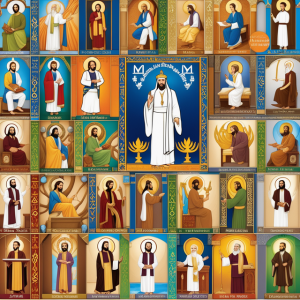“Bridges and Boundaries: A Comparative Study of World Religions, Including LDS and Hebrew Roots”


Introduction
In a world rich with spiritual diversity, understanding different faith traditions is more than just intellectual curiosity; it’s a vital step toward empathy, tolerance, and harmony. This post delves into major world religions such as Judaism, Christianity, Islam, Buddhism, and Hinduism, and offers a detailed comparison between the Latter-day Saints (LDS) Church and the Hebrew Roots Movement. The exploration goes beyond mere beliefs and practices, focusing on the deeper commitment to walking the Gospel as Yeshua did.
Section 1: Common Themes in Religious Traditions
Morality and Ethics
Universal moral principles guide human conduct across various religious traditions. From Judaism’s Ten Commandments to the Five Pillars of Islam, these ethical guidelines shape communities, laws, and personal behavior. They serve as a reminder of the shared human values that transcend cultural and religious boundaries.
The Afterlife and Eschatology
The concept of life after death, though varied, remains central to many faiths. Whether it’s Christianity’s belief in Heaven and Hell or Buddhism’s pursuit of Nirvana, these beliefs profoundly shape attitudes toward life, death, and ethical choices. They offer hope, guidance, and a sense of purpose in navigating life’s complexities.
Nature of the Divine
Understanding the divine takes different forms across cultures. Monotheistic religions like Judaism and Islam worship one God, known by different names such as Yehovah or Allah. Hinduism embraces a polytheistic view with multiple deities representing various aspects of life, while Buddhism focuses more on personal enlightenment than deity worship. These varied perspectives offer unique insights into the nature of existence and spiritual fulfillment.
Section 2: Differences in Practices, Rituals, and Beliefs
Rituals and Worship
The diversity of worship forms, from the Jewish Sabbath and Muslim Friday prayers to Buddhist meditation practices, enriches the global religious landscape. These practices reflect cultural variations, historical contexts, and spiritual philosophies, offering a window into the soul of different civilizations.
Sacred Texts and Authorities
Sacred texts like the Torah, Bible, Quran, and Vedas guide religious life, with rabbis, priests, imams, and monks shaping their interpretation. These scriptures and religious leaders play vital roles in guiding followers in their spiritual journeys, connecting them with centuries-old wisdom and divine inspiration.
Dietary Laws and Lifestyle
Dietary practices, such as kosher in Judaism, halal in Islam, and vegetarianism in Hinduism, often reflect deeper spiritual principles. They connect with broader ethical considerations, such as compassion for animals, purity, and personal discipline. These dietary laws offer insights into how faith translates into everyday choices and lifestyle.
Section 3: LDS Church vs. Hebrew Roots Movement
Beliefs and Practices
While the LDS Church emphasizes modern revelation and additional scriptures like the Book of Mormon, the Hebrew Roots Movement seeks to return to early Christian practices, aligning closely with Old Testament teachings and Jewish traditions. The desire to “walk as Yeshua walked” is central to Hebrew Roots, emphasizing a life modeled after Yeshua’s teachings, ethics, and love.
Scriptures
The LDS Church’s inclusion of modern scriptures contrasts with the Hebrew Roots Movement’s focus on the Torah and Old Testament. Hebrew Roots seeks to understand and apply the Scriptures as Yeshua and His early followers did, offering a rich connection to the historical and cultural context of the Bible.
Lifestyle and Community
Both traditions value family and community engagement but differ in areas such as missionary work, religious observances, and the interpretation of living a life mirroring Yeshua’s. The Hebrew Roots Movement emphasizes a holistic approach to faith, incorporating Jewish traditions and seeking to replicate the first-century church’s practices.
Walking the Gospel as Yeshua Did
Central to the Hebrew Roots Movement is the emphasis on living the Gospel as Yeshua lived it, following His teachings and examples in every aspect of life. This contrasts with the LDS Church’s approach, focusing more on modern revelation and guidance from current church leaders. This difference highlights the diverse ways in which followers seek to connect with the divine and live out their faith.
Section 4: Personal Reflection and Spiritual Journey
My transition from LDS to Hebrew Roots opened new spiritual horizons. It has been a journey of discovery, growth, and transformation. The emphasis on empathy, respect, and the importance of walking the Gospel as Yeshua did has provided a deeper connection to the Scriptures and a more authentic faith experience.
Conclusion
Through exploring the commonalities and distinctions among world religions, including a detailed comparison of the LDS Church and the Hebrew Roots Movement, we uncover a rich tapestry of beliefs and practices. Embracing these differences and seeking to understand the paths others walk fosters a more compassionate and understanding world. The call to walk as Yeshua did resonates as a timeless invitation to love, compassion, and truth.










